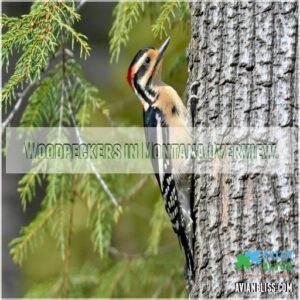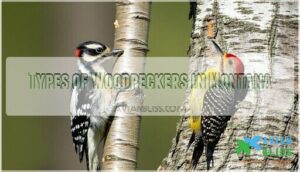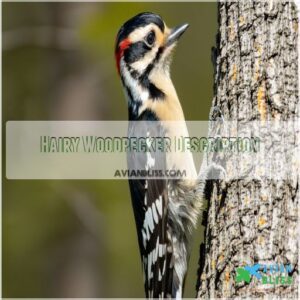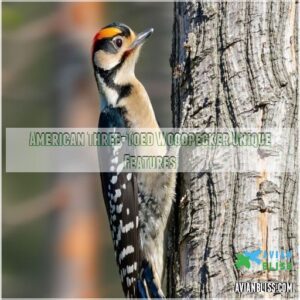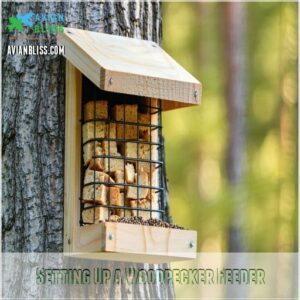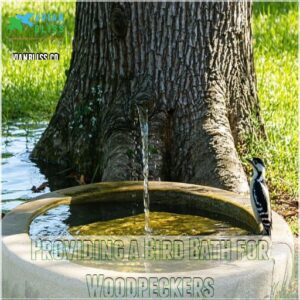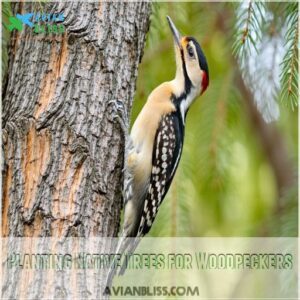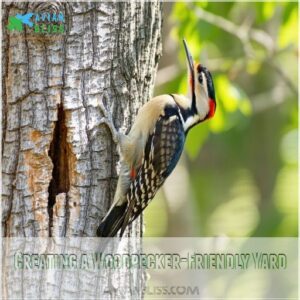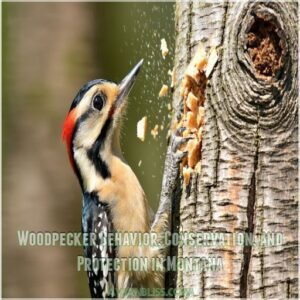This site is supported by our readers. We may earn a commission, at no cost to you, if you purchase through links.

These master carpenters of the forest create homes that benefit countless other species, while their distinctive drumming serves as nature’s morning alarm clock.
In Montana’s mountains and forests, you’ll spot these hardy birds year-round, though some species migrate seasonally.
The state’s varied habitats, from pine forests to aspen groves, provide perfect conditions for different woodpecker species.
Each has unique features and behaviors that make them fascinating to observe, especially their clever methods for finding food.
Table Of Contents
- Key Takeaways
- Woodpeckers in Montana Overview
- Types of Woodpeckers in Montana
- Woodpecker Habitat and Range in Montana
- Attracting Woodpeckers to Your Yard in Montana
- Woodpecker Behavior, Conservation, and Protection in Montana
- Frequently Asked Questions (FAQs)
- What kind of woodpeckers are in Montana?
- Are woodpeckers good to have in your yard?
- How rare is it to see a downy woodpecker?
- Why are woodpeckers pecking my house?
- What sounds do Montana woodpeckers make when drumming?
- Do Montana woodpeckers migrate during winter months?
- How deep are woodpecker holes in Montana trees?
- What predators threaten woodpeckers in Montanas forests?
- How long do Montana woodpeckers typically live?
- Conclusion
Key Takeaways
- You’ll find 10 distinct woodpecker species in Montana, from the common Northern Flicker to the rare Black-backed Woodpecker, each adapted to specific habitats from pine forests to aspen groves.
- Most Montana woodpeckers don’t migrate and stay year-round, though you’ll notice Red-headed Woodpeckers heading south in winter and Northern Flickers moving to lower elevations.
- You can attract woodpeckers to your yard by installing suet feeders 5-10 feet high, such as using a best woodpecker feeders, providing shallow bird baths near cover, and planting native trees like ponderosa pine and Douglas fir.
- You’ll recognize each species by their unique traits: Northern Flickers have spotted bellies and ground-feed on ants, Black-backed Woodpeckers thrive in burned forests, and tiny Downy Woodpeckers frequently visit backyard feeders.
Woodpeckers in Montana Overview
You’ll find ten remarkable woodpecker species throughout Montana’s diverse landscapes, from the tiny Downy Woodpecker to the striking Red-headed Woodpecker.
These skilled forest architects help maintain healthy ecosystems by controlling insect populations and creating nesting cavities that benefit other wildlife.
Importance of Woodpeckers in The Ecosystem
You’ll be amazed by how much woodpeckers contribute to forest health in Montana.
These remarkable birds act as nature’s pest control specialists, consuming vast quantities of bark beetles and other harmful insects that could devastate our forests.
They’re also ecosystem engineers, creating nesting cavities that become homes for countless other species, and often require specific Montana woodpecker habitat features, such as those found in products for woodpecker-friendly habitats.
Their drumming and foraging activities help maintain biodiversity and overall ecosystem balance throughout Montana’s diverse landscapes.
Brief Description of Montana Woodpecker Species
Montana’s woodpecker family is like a colorful tapestry of nature, featuring ten distinct species that call our state home. From the striking Red-headed Woodpecker to the industrious Black-backed Woodpecker, each brings its own character to our forests and backyards.
Here’s what makes Montana’s woodpeckers special:
- Size variations from the tiny Downy to the impressive Pileated
- Unique plumage patterns that help with quick field identification
- Specialized foraging techniques adapted to different habitats
- Year-round residents and seasonal visitors creating dynamic populations
Purpose of The Article
In this guide, we’ll explore Montana’s vibrant woodpecker population, helping you spot and identify these fascinating birds.
Whether you’re a seasoned birder or just starting out, you’ll discover where to find each species, learn their unique behaviors, and understand how to attract them to your backyard.
From the towering Pileated Woodpecker to the tiny Downy, we’ve got all the details you need to know.
Types of Woodpeckers in Montana
You’ll discover ten remarkable woodpecker species in Montana, ranging from the tiny Downy Woodpecker to the striking Red-headed Woodpecker.
Each species has unique features that help you identify them, like the Northern Flicker’s spotted belly and the Black-backed Woodpecker’s solid dark plumage.
Northern Flicker Characteristics
The Northern Flicker stands out as one of Montana’s most colorful woodpeckers, sporting a mix of brown plumage and bright yellow or red wing patches.
You’ll spot these unique birds foraging on the ground more often than in trees, hunting for their favorite snack – ants.
With distinctive black crescents on their chests and spotted undersides, Northern Flickers add a flash of beauty to Montana’s woodlands year-round.
Black-Backed Woodpecker Features
Frequently spotted in recently burned forests, Black-backed Woodpeckers showcase distinctive jet-black plumage that helps them blend with charred tree trunks.
They thrive in these environments, playing a key role in post-fire ecosystems.
You’ll quickly recognize these fascinating birds by their unique features:
- Solid black back that contrasts with white underparts
- Males sport a yellow crown patch
- Powerful, chisel-like bill perfect for extracting wood-boring beetles
- Three-toed feet specially adapted for gripping bark
Downy Woodpecker Identification
Meeting Montana’s smallest woodpecker is like finding a miniature masterpiece in your backyard.
You’ll spot these tiny dynamos by their black-and-white checkered wings and distinct white belly.
Males sport a charming red patch on their crown.
At just 6-7 inches long, Downy Woodpeckers make up for their small size with bold personalities, often visiting backyard feeders and darting between trees with acrobatic precision.
Red-Headed Woodpecker Distinctive Traits
Striking red-headed woodpeckers stand out among Montana’s feathered residents with their unmistakable crimson heads and black-and-white bodies.
You’ll find these charismatic birds showing off their unique personalities in three notable ways:
- They’re skilled aerial acrobats, catching insects mid-flight
- They’re nature’s clever hoarders, stashing food in bark crevices
- They’re fierce defenders of their territory, even removing other birds’ eggs
These bold birds hold special significance in Cherokee culture as symbols of war.
Hairy Woodpecker Description
The Hairy Woodpecker, a larger cousin of the Downy, packs quite a punch in Montana’s forests.
You’ll spot these feathered friends, like the Downy Woodpecker, which is the smallest woodpecker in North America and a common visitor to backyard bird feeders, by their distinctive black and white pattern, with males sporting a red patch on their heads.
They’re about the size of a robin, making them easy to identify among Montana’s woodpeckers.
| Feature | Male | Female |
|---|---|---|
| Size | 9.5 inches | 9.5 inches |
| Crown | Red patch | Black |
| Call | Sharp ‘peek’ | Sharp ‘peek’ |
American Three-Toed Woodpecker Unique Features
You’ll spot the American Three-toed Woodpecker by its distinctive three-toed feet, a rare adaptation among woodpeckers.
This medium-sized bird shows off a barred black-and-white back, with males sporting a yellow crown patch.
They’re fascinating to watch as they strip bark from dead trees to feast on wood-boring beetle larvae.
Look for them in Montana’s burned forests, where they’re perfectly adapted to thrive.
Other Woodpecker Species Found in Montana
Beyond Montana’s well-known woodpecker species, several remarkable visitors make occasional appearances.
Lewis’s Woodpecker, with its stunning green-black wings and pink belly, can be spotted in open ponderosa forests.
Williamson’s Sapsucker brings a splash of yellow to mountain forests, while White-headed Woodpeckers occasionally venture from Idaho into western Montana’s pine stands.
These species, such as the Red-headed Woodpecker with its vivid red head and protected status, add exciting diversity to Montana’s woodpecker population.
Woodpecker Habitat and Range in Montana
You’ll find Montana’s woodpeckers in diverse habitats across the state, from the burned forests where Black-backed Woodpeckers thrive to the suburban areas where Downy Woodpeckers frequently visit backyard feeders.
Each of Montana’s ten woodpecker species has adapted to specific environments.
Whether it’s the American Three-toed Woodpecker in Glacier National Park’s wooded areas or the Northern Flicker in open woodlands where they can forage on the ground.
Woodpecker Range and Migration Patterns
Many Montana woodpeckers stay put year-round, while others follow seasonal migration routes. You’ll spot Northern Flickers heading south during winter’s chill, but Black-backed Woodpeckers stick around for the long haul.
- Red-headed Woodpeckers cruise along river valleys, following insect populations
- Downy Woodpeckers hop between suburban yards and mountain forests
- Northern Flickers follow a clockwork pattern, departing in October
- American Three-toed Woodpeckers drift between elevations with beetle outbreaks
Montana’s Diverse Woodpecker Habitat
Montana’s diverse landscape creates perfect homes for woodpeckers, from dense pine forests to open woodlands.
Here’s what makes each habitat unique:
| Habitat Type | Key Features | Primary Species |
|---|---|---|
| Coniferous Forests | Tall pines, dead snags | Black-backed, Three-toed |
| Mixed Woodlands | Varied tree species | Northern Flicker, Downy |
| Burned Areas | Standing dead trees | Black-backed, Three-toed |
Woodpeckers in Montana can also be supported by creating a woodpecker-friendly environment, using products specifically designed for Woodpecker habitat Montana, such as those found in Woodpecker Habitat Products.
These habitats face ongoing challenges from climate change and forest management practices, affecting woodpecker populations across the state.
Woodpeckers Found in Specific Regions of Montana
Your woodpecker-watching journey through Montana reveals distinct species in each region.
Here’s where you’ll spot these fascinating birds:
- Western Montana, including Glacier National Park and Missoula’s forests, hosts the American Three-toed and Black-backed Woodpeckers
- Central Montana‘s mixed woodlands welcome Northern Flickers and Hairy Woodpeckers year-round
- Eastern Montana‘s riverside corridors attract Red-headed Woodpeckers during breeding season
Each region offers unique opportunities to observe these remarkable birds in their natural settings.
Habitat Requirements for Different Woodpecker Species
Each woodpecker species in Montana seeks out specific home sweet homes.
Black-backed Woodpeckers making themselves cozy in recently burned forests.
Northern Flickers prefer open woodlands with ground access for ant-hunting.
Downy Woodpeckers adapt well to suburban life, but their larger cousins, the Hairy Woodpeckers, stick to mature forests.
The American Three-toed Woodpecker calls high-elevation coniferous forests home.
Attracting Woodpeckers to Your Yard in Montana
You’ll find that attracting Montana’s woodpeckers to your yard isn’t as challenging as you might think, especially when you provide the right combination of feeders, food, and native trees.
Your efforts to create a woodpecker-friendly habitat, which can also attract other bird species like the black-and-white birds in Florida with contrasting black and white plumage, will reward you with regular visits from these fascinating birds, from the tiny Downy Woodpecker to the striking Northern Flicker.
Setting Up a Woodpecker Feeder
Getting woodpeckers to visit starts with the right feeder setup.
Choose a sturdy suet feeder and mount it on a thick tree trunk or wooden post about 5-10 feet high.
Here’s what you’ll need:
- A double-sided suet cage feeder with tail props
- High-quality suet cakes rich in nuts and insects
- Weather-resistant mounting hardware
Check and refill feeders weekly, and clean them monthly with a mild soap solution to prevent mold growth.
Providing a Bird Bath for Woodpeckers
Three key features make a bird bath irresistible to woodpeckers: shallow water (1-2 inches deep), textured surfaces for secure footing, and proper placement near cover.
Position your bath 3-4 feet off the ground, ideally near trees or shrubs where woodpeckers feel safe.
Keep the water fresh and clean daily, especially during summer months when birds need reliable water sources for drinking and bathing.
Planting Native Trees for Woodpeckers
Native trees serve as natural magnets for woodpeckers in your Montana yard.
Plant a mix of dead and living trees like ponderosa pine, Douglas fir, and quaking aspen to create ideal habitats.
These trees provide essential nesting sites and attract insects that woodpeckers love.
Local nurseries can help you select disease-resistant varieties that’ll thrive in your specific region while supporting these fascinating birds.
Offering a Variety of Food for Woodpeckers
Throughout the year, woodpeckers crave different foods to maintain their energy.
Suet is a high-energy favorite, especially during winter months.
Mix things up with nuts like peanuts and sunflower seeds, which perfectly mimic their natural diet.
Don’t forget about insects – mealworms are a protein-rich treat that’ll keep them coming back.
Fresh fruits like apples and berries add variety to their menu.
Creating a Woodpecker-Friendly Yard
Beyond offering food, making your yard a woodpecker paradise means creating their ideal habitat.
Like planning the perfect party, you’ll want to set up all the right amenities.
Here’s what works best:
- Keep dead trees standing (if safe) – they’re woodpecker condos
- Install nest boxes at various heights
- Create brush piles to attract tasty insects
- Plant native berry bushes and fruit trees
- Add multiple suet feeders in shaded spots
Woodpecker Behavior, Conservation, and Protection in Montana
You’ll discover how Montana’s woodpeckers use their specialized beaks to find food, communicate through drumming, and build nests in different types of trees.
Woodpeckers play a key role in maintaining healthy forest ecosystems across the state.
By understanding their behavior and habitat needs, you can help protect these remarkable birds.
Foraging Methods of Different Woodpecker Species
Each woodpecker species in Montana has evolved unique foraging strategies to survive.
Northern Flickers dine on ants at ground level.
Black-backed Woodpeckers strip bark from burnt trees to feast on wood-boring beetles.
Downy Woodpeckers prefer caterpillars and beetle larvae hidden in small branches.
Red-headed Woodpeckers catch insects mid-flight, storing extra food in tree crevices for later.
Woodpecker Drumming and Communication
Drumming against tree trunks serves as more than just a feeding strategy for Montana’s woodpeckers.
You’ll hear these birds using distinct patterns and rhythms to communicate with potential mates, establish territory, and warn off rivals.
Their "language" varies by species – from the rapid-fire drumming of the Downy Woodpecker to the slower, more deliberate beats of the Pileated Woodpecker.
Think of it as nature’s Morse code.
Woodpecker Nesting and Breeding Habits
Montana’s woodpeckers are master architects in terms of nesting. They’ll carve out their homes in dead trees, creating perfectly round holes that measure 1-4 inches wide, often selecting sites with softer wood for easier excavation, a trait shared by their counterparts in Vermont, where woodpeckers play a significant role in the ecosystem woodpeckers in Vermont.
During breeding season (May-July), females lay 3-6 glossy white eggs.
You’ll find most nests 6-20 feet above ground, though some species like Northern Flickers prefer higher spots up to 100 feet.
Chicks typically fledge after 24-28 days of devoted parental care.
Woodpecker Migration Patterns
Most woodpecker species in Montana stay put year-round, though you’ll notice some seasonal shifts in their behavior.
These fascinating birds have adapted to handle Montana’s harsh winters, unlike their fair-weather feathered friends.
To make the most of this time, enthusiasts can attract woodpeckers to their yards with Montana woodpecker feeders.
- Red-headed woodpeckers move south when insect populations drop
- Northern flickers shift to lower elevations during winter months
- Black-backed woodpeckers travel to recently burned forests for food
Conservation and Protection of Montana Woodpeckers
The preservation of Montana’s woodpeckers faces pressing challenges, from habitat loss to climate change impacts.
You’ll find that these remarkable birds are particularly vulnerable to forest management practices that remove dead trees and snags.
Conservation efforts focus on protecting their habitats through sustainable forestry, maintaining wildlife corridors, and monitoring population trends.
By supporting local conservation initiatives, you’re helping make sure these important species continue to thrive.
Frequently Asked Questions (FAQs)
What kind of woodpeckers are in Montana?
At least 10 diverse woodpecker species call Montana home, including the striking Red-headed Woodpecker, tiny Downy Woodpecker, ground-foraging Northern Flicker, and rare Black-backed Woodpecker that thrives in burnt forests.
Are woodpeckers good to have in your yard?
Having woodpeckers in your yard helps control insect populations, especially harmful tree pests.
They’ll naturally aerate your trees, promote biodiversity, and provide delightful birdwatching opportunities while maintaining your landscape’s ecological health.
How rare is it to see a downy woodpecker?
If you’re in Massachusetts, you might be familiar with the American Robin’s rust-red breast and melodious songs, as they’re known to be common backyard birds backyard birds of Massachusetts. Downy woodpeckers aren’t rare at all – you’ll likely spot these common backyard visitors year-round.
The Downy woodpecker, also found in North Dakota with a widespread presence, is known to be one of North Dakota’s woodpeckers. Downy woodpeckers are North America’s most abundant woodpecker species, frequently seen at feeders and in suburban areas across the continent.
Why are woodpeckers pecking my house?
Woodpeckers might be drumming on your house to attract mates, mark territory, or search for insects in the siding.
They’re particularly drawn to wooden surfaces and may mistake your home for a hollow tree.
What sounds do Montana woodpeckers make when drumming?
Each woodpecker has their unique drum beat: you’ll hear rapid-fire taps from Downys, slow booming from Pileateds, and quick drumrolls from Flickers. Their rhythms range from 8-22 beats per second.
Do Montana woodpeckers migrate during winter months?
Most Montana woodpeckers stay put year-round, but you’ll find that Red-headed Woodpeckers head south during winter. The Northern Flicker, Downy, and Hairy Woodpecker species tough out the cold months locally.
How deep are woodpecker holes in Montana trees?
A typical woodpecker cavity depth ranges from 8 to 24 inches, depending on the tree’s size and species.
You’ll find these essential nesting holes vary in width too, usually spanning 2 to 6 inches across.
What predators threaten woodpeckers in Montanas forests?
In Montana’s forests, you’ll find hawks, owls, and snakes actively hunting these birds.
House cats pose threats near urban areas, while weasels and squirrels often raid nests for eggs and chicks.
How long do Montana woodpeckers typically live?
You’d think these feathered drummers live forever, but Montana’s woodpeckers typically survive 4-12 years in the wild, depending on species. The Northern Flicker can reach 9 years, while Downy Woodpeckers average
Conclusion
Like sentinels of Montana’s forests, woodpeckers serve as nature’s architects, creating homes that support entire ecosystems.
Whether you’re spotting Northern Flickers in your backyard or searching for elusive Black-backed Woodpeckers in burned forests, these remarkable birds showcase nature’s incredible diversity.
By understanding and protecting woodpeckers in Montana, you’re not just helping these fascinating creatures – you’re supporting the health of our entire forest ecosystem.
So grab your binoculars and start exploring – adventure awaits!

